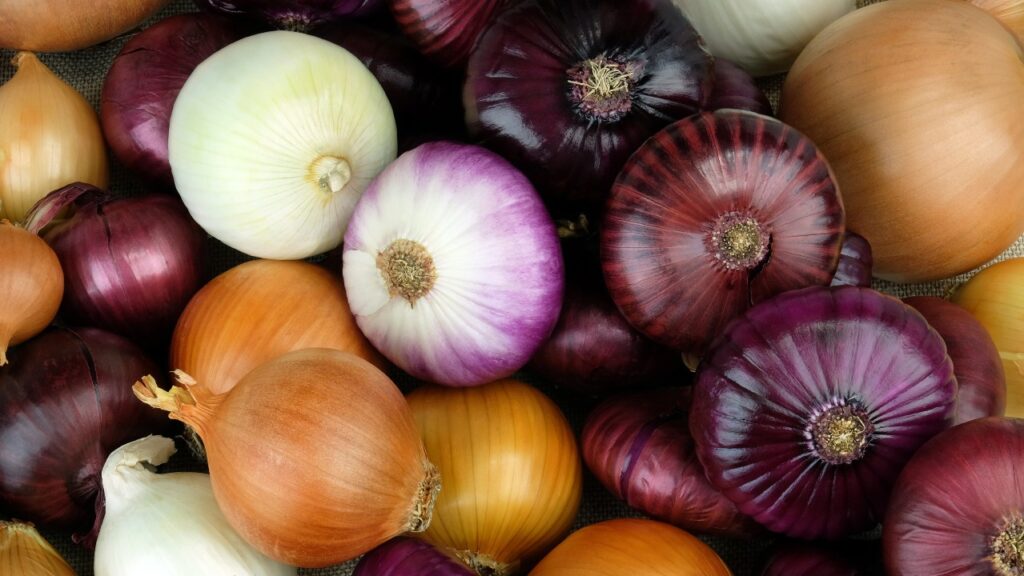Onions are an essential ingredient in many dishes, and growing your own onions can be a rewarding experience. However, growing onions in Texas can be a bit of a challenge due to the hot, dry weather that is prevalent in the state. In this article, we will share some tips and tricks to help you grow onions successfully in Texas.
We may earn an affiliate commission for purchases using our links at no added cost to you.

Choosing the Right Onion Varieties
There are many onion varieties available, but not all are suitable for Texas weather conditions. You need to choose the right variety that can tolerate the hot, dry climate in Texas. The most popular onion varieties for Texas are:
- Texas Early White: This variety is popular in Texas and is an early-season onion. It can be grown in fall or early winter, and it takes about 90 days to mature.
- Red Creole: This variety is an excellent choice for those who love red onions. It is a mid-season onion and takes about 110 days to mature.
- Bermuda: This variety is an excellent choice for those who live in the southern part of Texas. It is a sweet onion and takes about 100 days to mature.
Planting Onions in Texas
Onions can be grown from seeds, sets, or transplants. If you are growing onions from seeds, you need to start them indoors in late fall or early winter. If you are growing onions from sets or transplants, you can plant them directly in the garden.
When planting onions, choose a well-drained area with full sun exposure. Onions prefer soil that is slightly acidic, with a pH between 6.0 and 6.8. Before planting, amend the soil with compost or well-rotted manure to improve its texture and fertility.
Plant onion sets or transplants about 1 inch deep and 4-6 inches apart. If you are planting onion seeds, plant them about 1/4 inch deep and 1 inch apart. Keep the soil moist but not waterlogged.
Caring for Onions in Texas
Onions require regular watering and fertilization to grow well. Water onions deeply once a week, especially during dry spells. Avoid overhead watering, as this can increase the risk of diseases.
Fertilize onions every 3-4 weeks with a balanced fertilizer that is high in nitrogen. Nitrogen is essential for onion growth and development.
Weed onions regularly to prevent competition for nutrients and water. Onions have shallow roots, so be careful not to disturb them when weeding.
Common Onion Pests and Diseases in Texas
Onions are susceptible to several pests and diseases in Texas, including:
- Onion maggots: These pests can cause significant damage to onion bulbs. You can prevent them by using row covers and avoiding planting onions in the same area for more than two years.
- Thrips: These tiny insects can cause damage to onion leaves and can transmit diseases. You can control them by using insecticidal soap or neem oil.
- Fusarium basal rot: This disease can cause the onion bulbs to rot. You can prevent it by planting disease-resistant varieties and avoiding overwatering.
Harvesting Onions in Texas: Tips for a Long-Lasting Harvest
After months of care and attention, it’s time to harvest your onions. Harvesting onions in Texas can be a bit tricky, but with the right techniques, you can ensure a bountiful and long-lasting harvest. In this article, we’ll share some tips for harvesting and storing onions in Texas.
When harvesting onions, wait until the tops start to yellow and fall over. This indicates that the onions have stopped growing and are ready to be harvested. Gently loosen the soil around the bulb with a fork or spade, being careful not to damage the bulb. Once the bulbs are loose, carefully lift them out of the soil and let them dry in the sun for a few days.
Once the outer skin is dry, brush off any excess soil and remove the tops. Cut the tops about 1 inch above the bulb, leaving a small stem to help the onion dry. Do not cut the stem too short, as this can increase the risk of rotting.
To store onions, choose a cool, dry, and dark place with good ventilation. A pantry, garage, or basement can be ideal. Avoid storing onions near potatoes, as the ethylene gas produced by potatoes can cause onions to spoil.
To store onions, you can use a mesh bag, a wicker basket, or a wooden crate. Do not store onions in plastic bags, as this can cause them to sweat and rot. Place the onions in the container, being careful not to overcrowd them. Leave some space between the onions to allow for air circulation.
Stored properly, onions can last for several months. Check your onions regularly for signs of spoilage, such as mold or soft spots. Remove any spoiled onions immediately to prevent the spread of rot to the other onions.
FAQs About Growing Onions in Texas
Can onions be grown year-round in Texas?
Onions can be grown year-round in Texas, but the best time to plant them is in the fall or early winter. This allows the onions to mature before the hot summer weather sets in.
How do I know when my onions are ready to harvest?
Onions are ready to harvest when their tops start to yellow and fall over. Once this happens, stop watering the onions, and let the bulbs dry in the sun for a few days. When the outer skin is dry, brush off any soil and store the onions in a cool, dry, and dark place.
What can I do to prevent onion maggots from attacking my onions?
Onion maggots can be prevented by using row covers and avoiding planting onions in the same area for more than two years. You can also plant onion sets or transplants with a bit of wood ash to deter onion maggots.
What is the best way to fertilize onions?
Onions require regular fertilization to grow well. Fertilize onions every 3-4 weeks with a balanced fertilizer that is high in nitrogen. Nitrogen is essential for onion growth and development. You can also side-dress onions with a high-nitrogen fertilizer halfway through the growing season.
Conclusion
Growing onions in Texas can be a bit challenging, but with the right care and attention, you can grow a bountiful harvest. By choosing the right onion varieties, planting in the right soil, and providing regular care, you can successfully grow onions in Texas.
Remember to water your onions deeply, fertilize regularly, and weed regularly to prevent competition for nutrients and water. Also, watch out for common pests and diseases like onion maggots, thrips, and Fusarium basal rot. With these tips and tricks, you’ll be able to grow delicious onions that will add flavor and nutrition to your meals.
Top Selling Gardening Tools Today
Last update on 2025-06-06 / Affiliate links / Images from Amazon Product Advertising API

About Author
Hannah Anderson is a passionate garden enthusiast with over a decade of experience. She has been sharing her knowledge and expertise on this website and her articles and tips have helped countless individuals create beautiful and thriving gardens. Whether you’re a seasoned green thumb or just starting out, Hannah’s practical advice and creative ideas will inspire and guide you on your gardening journey.







